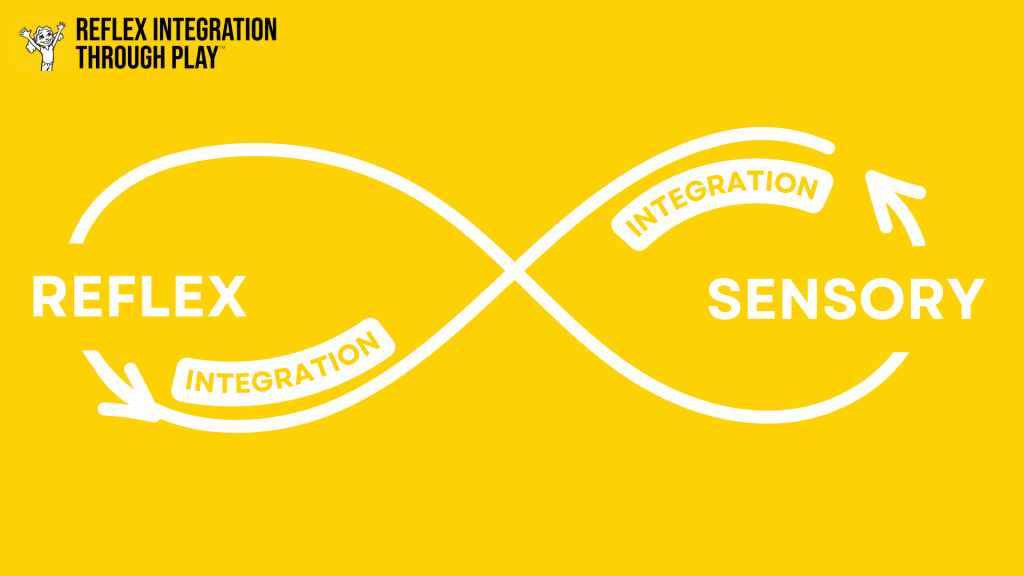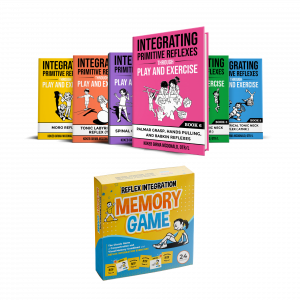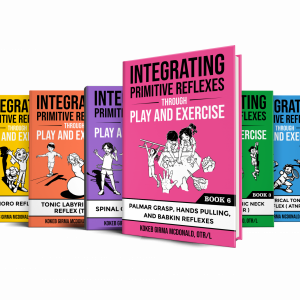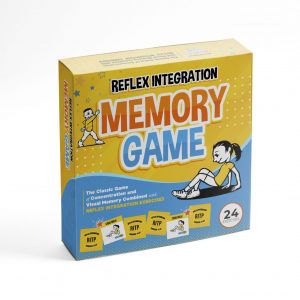Sensory integration and reflex integration are two vital components that shape the foundation of a child’s development. They are intricately woven and working together to create movement, cognition, and sensory processing and perception. When it comes to integration, you can not have one without the other. In this blog post, I want to delve into the relationship between sensory and reflex integration, emphasizing the importance of addressing them together for comprehensive therapeutic interventions.
Understanding the Foundations:
Sensory integration is the process through which the body receives, interprets, and responds to sensory information. It’s the brain’s ability to make sense (i.e., process and perceive) of the environment through touch, sight, sound, taste, smell, proprioception, vestibular, and interception.
Reflexes, on the other hand, are automatic responses triggered by sensory stimuli without reaching the cortical (conscious) part of the brain. Each reflex arc has a sensory trigger and motor output (i.e., reaction). Reflex integration plays a crucial role in the developmental journey, aiding the maturation of the brain-body connection. Infants engage in repetitive movements, fostering myelination and the establishment of neural pathways. So, we can say that reflex maturation and integration aid sensory processing and integration.

Sensory Integration ♾️ Reflex Integration
Let’s break down a seemingly simple activity – a child reaching for a toy. This simple action involves a complex interplay of reflexes and sensory information processing.
Let’s break down some of the steps 👉🏾 a child sees or hears a toy, triggering a response.
- Asymmetrical Tonic Neck Reflex (ATNR): the child turns towards the toy, activating the ATNR, leading to the extension of the arm and leg on the head-turned side.
- Palmar Grasp Reflex: the child reaches and touches the toy, triggering the Palmar Grasp Reflex, facilitating hand flexion.
- Hands Pulling Reflex: the child grasps the toy, activating the Hands Pulling Reflex, flexing the elbows to bring the toy closer.
- Babkin Palmomental reflex triggers an exploration of the toy with the mouth.
| Sensory trigger | Reflex triggered | Reflex response | Sensory processing | |
| 1 | Auditory: Child turns toward a toy | ATNR: head turns towards the toy | Extension of the arm & leg on the head-turned side | “I can reach the toy.” “That is the toy that is making noise, etc.” |
| 2 | Touch: hand reaches the toy | Palmar Grasp | Hand flexion over the toy | “I can grab the toy.” “I feel the toy, etc.” |
| 3 | Touch: hand grasps the toy | Hands pulling | Flexing the elbows to bring the toy closer. | “I can bring the toy to me.” “I can bring myself closer to the toy., etc.” |
| 4 | Touch: hand grasps the toy | Babkin Palmomental | Exploration of the toy with the mouth | “I can learn about the toy, taste, texture, etc.” |
As we peel back the layers to understand the foundations, sensory integration allows the brain to make sense of the world through various channels—touch, sight, sound, taste, smell, and more. Simultaneously, reflex integration, those automatic responses hardwired in our system, plays a vital role in building the brain-body connection during a child’s developmental journey.
Let’s revisit the simple act of a child reaching for a toy. It’s not just a grab-and-go scenario; it’s a symphony of reflexes and sensory processing working together seamlessly. From the auditory trigger to reflex responses like the Palmar Grasp and Hands Pulling Reflex, each step is a dance between sensory input and automatic reactions.
Breaking down the steps, we see how these reflex patterns evolve from repetitive movements, gradually transforming into purposeful actions. The journey involves countless repetitions, paving the way for crucial developmental milestones like rolling, sitting, crawling, and walking. Nature has programmed these reflex “codes” within us, and it’s through exploration that children fine-tune their brain-body connection.
Clinical Implications: Occupational therapists and pediatric specialists are key to unlocking the potential within this intricate interplay. When faced with a child wrestling with sensory processing challenges, delving into retained reflexes becomes a game-changer. Asking critical questions about how sensory information is processed and which reflex patterns are at play allows therapists to dig deeper and address the root causes.
It’s not just about offering coping skills; it’s about creating a treatment plan that goes to the core of the issue. By approaching sensory challenges from this foundational level, therapists can provide effective and transformative interventions for a child’s development.
Fundamentally, sensory and reflex integration extends beyond mere theoretical understanding—it serves as a guide and building block shaping a child’s journey toward optimal development.
Are you an occupational therapist seeking to advance your clinical skills? Do you want to join the RITP Certification program but have further questions? Book a call here.



